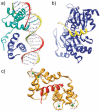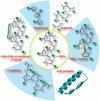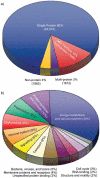Assessment of helical interfaces in protein-protein interactions
- PMID: 19668855
- PMCID: PMC4575789
- DOI: 10.1039/b903202a
Assessment of helical interfaces in protein-protein interactions
Abstract
Herein we identify and analyze helical protein interfaces as potential targets for synthetic modulators of protein-protein interactions.
Figures





References
Publication types
MeSH terms
Substances
Grants and funding
LinkOut - more resources
Full Text Sources
Other Literature Sources

